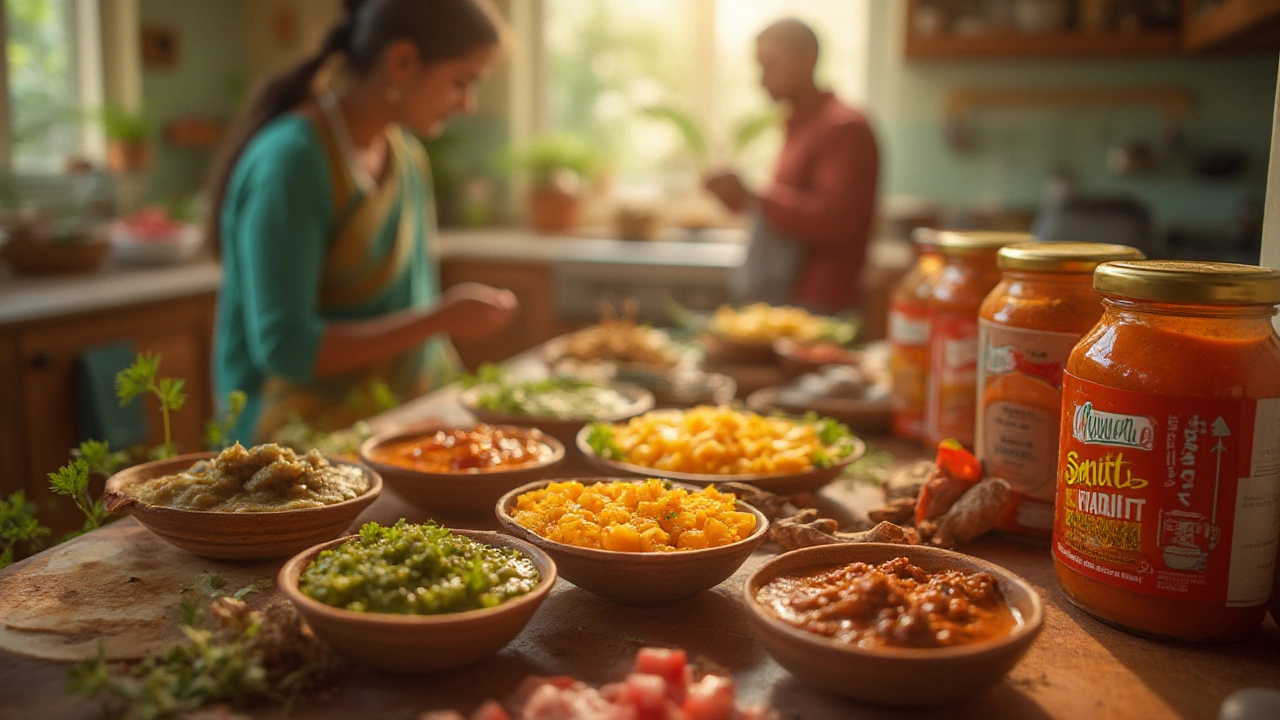It’s funny how one simple question can expose just how differently two cultures experience food. Go ahead—ask your average American what they call "chutney." Don’t be surprised if they pause and look puzzled. Most Americans have heard the word, sure, but odds are, the image in their mind is a jar on the bottom shelf labeled “Major Grey’s Mango Chutney,” probably next to the pickles and jelly in some lonely supermarket aisle. And that’s if they’ve even seen it at all.
Chutney, as anyone familiar with Indian kitchens will tell you, is more than just a mango marmalade. But in the American grocery world, chutney usually gets turned into something entirely different—something sweeter, thicker, and not nearly as varied as what you'd find in India. So, when a recipe calls for chutney and you’re shopping in the U.S., the answer to “what do Americans call chutney?” often boils down to a few different terms—relish, jam, or maybe even sauce. But these answers miss a lot of the nuance and flavor. Let’s dig in.
What Does Chutney Mean in India and Around the World?
Walk into any kitchen from Delhi to Chennai and ask for chutney, and you might get dozens of different bowls filled with thick, spicy pastes, fresh herby dips, runny coconut sauces, or fruit-packed preserves. The word “chutney” actually comes from the Hindi word ‘chatni’—meaning ‘to lick’ or ‘to eat with appetite.’ In India, it’s an umbrella term. If you make a spicy, tangy condiment out of fruits, veggies, spices, and maybe some sugar, you’ve got a chutney.
Chutneys in South Asia are wild and diverse. There’s classic mint-coriander chutney, fiery red tomato chutney, creamy coconut chutney, tamarind chutney, and dozens more—each served alongside dishes to add punch or cool things off, depending on the spices. Some are thick and smooth; others are chunky. Some are sweet, but most have a bold hit of heat and tang that Americans don’t usually associate with the jars labeled “chutney” in U.S. stores.
The British, during their years in colonial India, developed a taste for chutneys, but British chutney ended up being more like a fruit preserve, tangy and very sweet, loaded with vinegar, cooked for a long time, so it could survive long sea voyages. That’s the version that landed in American supermarkets as "Major Grey’s Chutney"—a thick, golden sauce packed with bits of mango, vinegar, and sugar, with a mild flavor.
What’s interesting? Even the “authentic” Major Grey never existed—he’s more likely a brand invention than a real person, illustrating just how deeply chutney has crossed and then tangled culinary lines around the world. While Indian chutneys are almost always served fresh and made by hand, the American version in a jar is shelf-stable, deeply sweet, mellow, and honestly, bears little resemblance to its bold Indian cousin.
How Do Americans See and Use Chutney?
Now, let’s talk about America’s relationship with the word "chutney." For most people in the U.S., chutney means just one thing: mango chutney. And almost always, it’s the store-bought, British-style version mentioned earlier: sweet, tangy, spoon-able, mild. In Indian restaurants here, you might see tiny metal ramekins with mint, tamarind, or coconut chutneys—usually just called "mint sauce" or "tamarind sauce" on the menu, which can confuse anyone looking for the actual word "chutney."
A big chunk of Americans probably haven’t even tasted chutney—unless they love Indian takeout or are curious home cooks. According to a Statista survey from 2023, less than 12% of U.S. households report buying any kind of chutney each year, compared to over 45% for salsa or more than 80% for ketchup. When most Americans want something sweet and tangy on the side, they’ll reach for jam, jelly, or, in a pinch, what they call relish. And if you ask around, you’ll discover that for a lot of people, “relish” means chopped pickles with a bit of sugar, meant for hot dogs, not curries.
So, is there an American equivalent to chutney? Sort of. The closest thing might be relish (think of the chunky, tangy stuff people put on burgers and sausages) or even cranberry sauce, which gets served with Thanksgiving turkey but is also tart and sweet. But truly, nothing in the classic American condiment lineup—ketchup, BBQ sauce, mayonnaise, yellow mustard—fills chutney’s spot exactly. Chutney is still seen as an "exotic" or imported food, something special for certain meals or when you want to make a cheese and charcuterie platter pop.
There’s also the confusion caused by American branding. Grocery stores will sometimes call Indian-style chutney a "fruit spread" or "savory jam," especially when trying to entice folks who aren’t familiar with Indian cooking. You’ll spot stuff labeled as “spicy mango relish” or “ginger-apple chutney,” and if you look at the ingredients, usually sugar is right up there as a main ingredient. If you actually want the proper Indian flavor—less sugar, more spice—you’ll have better luck at a specialty Indian grocery.
| Term | Common Ingredients | Texture | Typical Use in America |
|---|---|---|---|
| Mango Chutney | Mango, sugar, vinegar, spices | Thick, chunky | With curries, as a cheese pairing |
| Relish | Pickles, onions, peppers, sugar | Chunky, wet | Hot dogs, burgers |
| Jam/Jelly | Fruit, sugar, pectin | Gel-like | Toast, PB&J |
| Salsa | Tomato, chili, onion, cilantro | Chunky, wet | Tortilla chips, tacos |
| Cranberry Sauce | Cranberries, sugar | Gel, chunky | Thanksgiving turkey |

How Do Chutney Recipes Get Adapted in the U.S.?
The way American cooks adopt and adapt chutney is kind of fascinating. Sometimes you’ll see recipes on food blogs or YouTube channels labeled “chutney” that are basically syrupy jams with a bit of ginger. Many home cooks love the *idea* of chutney—they want something that gives a dish a sweet and spicy punch—but they’re unsure how to make it or what to use. Typically, the American approach is to go heavy on sweetness, reducing complexity to just a fruit and some sugar, maybe some vinegar for tang. For a genuinely Indian flavor, you need to go next level: lots of fresh herbs, mustard seeds crackling in hot oil, tangy tamarind, green chilies—basically, layers of sharp flavors balanced out by just enough sweetness to bring it all together.
This is why, if you peek at top-rated “chutney” recipes in American cookbooks or websites, you often get things like “Apple Chutney” or “Tomato Chutney”—more like a chutney-inspired preserve, cooked low and slow, canned for winter. It’s delicious on pork chops or as a sandwich spread, no doubt, but it only loosely matches what a South Asian family would recognize as chutney.
Still, the tide is turning. Interest in global cooking is booming, and TikTok and Instagram foodies are going nuts over recipes that use cilantro-mint chutney for everything from tacos to salad dressings. Some high-end American restaurants now serve chutneys with roast lamb or cheese plates, and some companies are making fresher, less sugary versions you can buy chilled or even frozen, with bold flavors and real chunks of chili and ginger. Take Brooklyn Delhi, a New York start-up, for example: their “Roasted Garlic Achaar” is as close as you’ll find to real Indian chutney on an American grocery shelf.
Stores like Trader Joe's have tossed their own take on “chutney” into the ring, too, often as a seasonal special. But the magic of true chutney—its wild freshness and sharp, specific flavors—still tends to get lost in translation. If you want the real thing, homemade rules. Luckily, most chutney recipes are easy to whip up if you’ve got a blender and a few herbs and spices. And if you can get your hands on some fresh coconut, green chilies, or tamarind, a whole world opens up.
- Mango Chutney: Best-selling in the U.S., but sweeter and milder than in India.
- Cilantro-Mint Chutney: Becoming popular with foodies for its bright flavor.
- Tamarind Chutney: Used in samosa dipping sauces at Indian restaurants.
- Cranberry or Tomato "chutneys": Often homemade, with more American flavors but still inspired by the Indian concept.
Tips for Finding or Making Chutney in America
If you’re shopping at a typical American grocery store, you’re most likely to find chutney in the international foods section. It’ll almost always say "mango chutney" on the label, and chances are, it comes from either an American or British brand. Want something closer to what’s served in India? Aim for specialty stores—Indian grocers carry a range of jarred options, from bright green coriander chutney to fiery red garlic chutney, or even frozen coconut chutneys that taste just like a South Indian breakfast table.
Don’t worry if you can’t find a jar—making fresh chutney at home is straightforward. Start with your backbone flavor: cilantro, mint, tomatoes, tamarind, coconut, or mango. Toss in aromatics—think garlic, ginger or chili. Bulk it up with onions or peanuts for texture, and finish with lemon juice or vinegar and a pinch of sugar. Blend until smooth or leave a little chunk for texture. If you want that real “pop,” heat a spoonful of oil, fry mustard seeds with a pinch of urad dal (split black lentil), and pour it over the chutney—your kitchen will smell utterly amazing.
For creative cooks, don’t be scared to toss a spoonful of chutney into your grilled cheese, swirl a dollop into winter squash soup, or brighten up chicken salad with a tangy apple-ginger version. Chutney’s versatility is exactly what’s missing from American tables. Why stick with just mayo or ketchup?
Here’s how to read those labels when you’re in the aisle and not sure what you’re about to buy:
- If the jar says “relish” but ingredients list vinegar, sugar, and mild veggies or fruit, it’s probably an American-style sweet relish, not really chutney.
- If the jar has the word “chutney,” but the first two ingredients are sugar and vinegar, expect something sweet and mild, not spicy.
- Look for brands imported from India if you want classic flavors—Patak’s, Swad, or Mother’s Recipe are safe bets for genuine options.
- For freshest results, whip up a homemade batch—a blender and 10 minutes is all you need, with ingredients from your regular produce bin.
One last pro tip: try pairing chutney as Americans pair relish or jam—on burgers, sandwiches, or with cheese and cured meats. The sweet-tartness and bold flavors are so much more interesting than plain ketchup.
So, when someone asks, "What do Americans call chutney?"—now you’ve got the facts, and a whole shopping list of fresh, zippy, and addictively tasty ideas. Call it what you like—relish, jam, sauce—but it’s a culinary wildcard just waiting to get more love in American kitchens.
